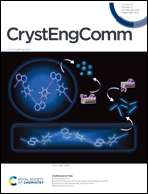Cathodic synthesis of a Cu-catecholate metal–organic framework†
Abstract
Processing conductive two-dimensional (2D) metal–organic frameworks (MOFs) into films on a substrate is important for their applications ranging from energy conversion and storage to devices of various types. Here, we report the cathodic synthesis of uniform films of Cu-CAT-1, one of the conductive M-catecholate MOFs (M3HHTP2, M = Cu2+, Ni2+, or Co2+ and H6HHTP = 2,3,6,7,10,11-hexahydroxytriphenylene, respectively). This cathodic strategy relies on the electrochemical reduction of oxygen to trigger the formation reaction of MOF materials. Importantly, cyclic voltammetry (CV) studies reveal that the O2 reduction can be promoted greatly by the acidic copper ions and H6HHTP ligand, which decreases significantly the overpotential for the cathodic synthesis of Cu-CAT-1 and thus avoids effectively the plating of metallic copper. Based on the systematical investigation on the effects of solution conductivity, reactant concentrations, and working potential on the growth kinetics of Cu-CAT-1, dense films with uniform thickness ranging from 70 nm to 1700 nm were synthesized under the optimized experimental conditions.

- This article is part of the themed collection: Crystal Growth


 Please wait while we load your content...
Please wait while we load your content...